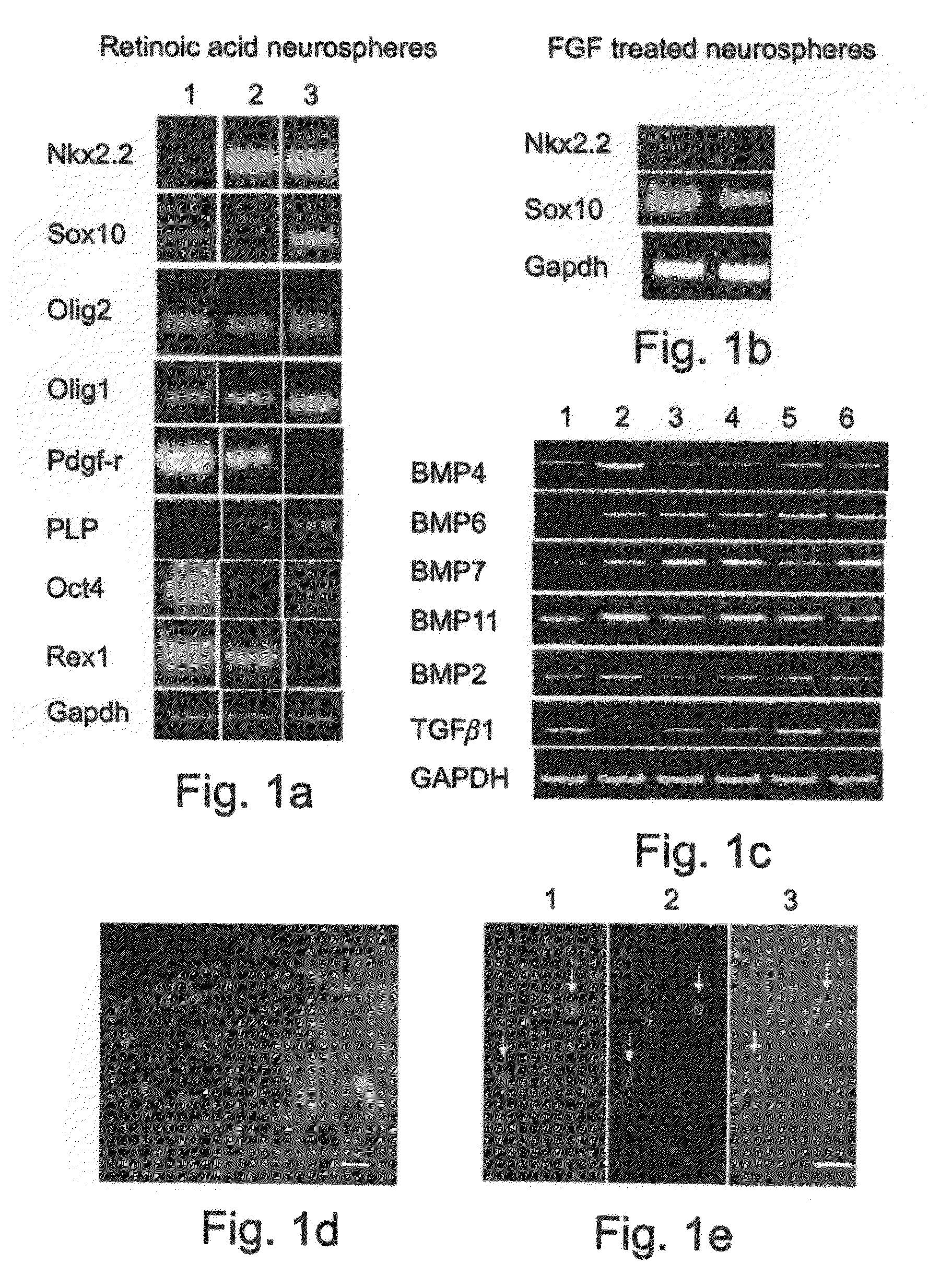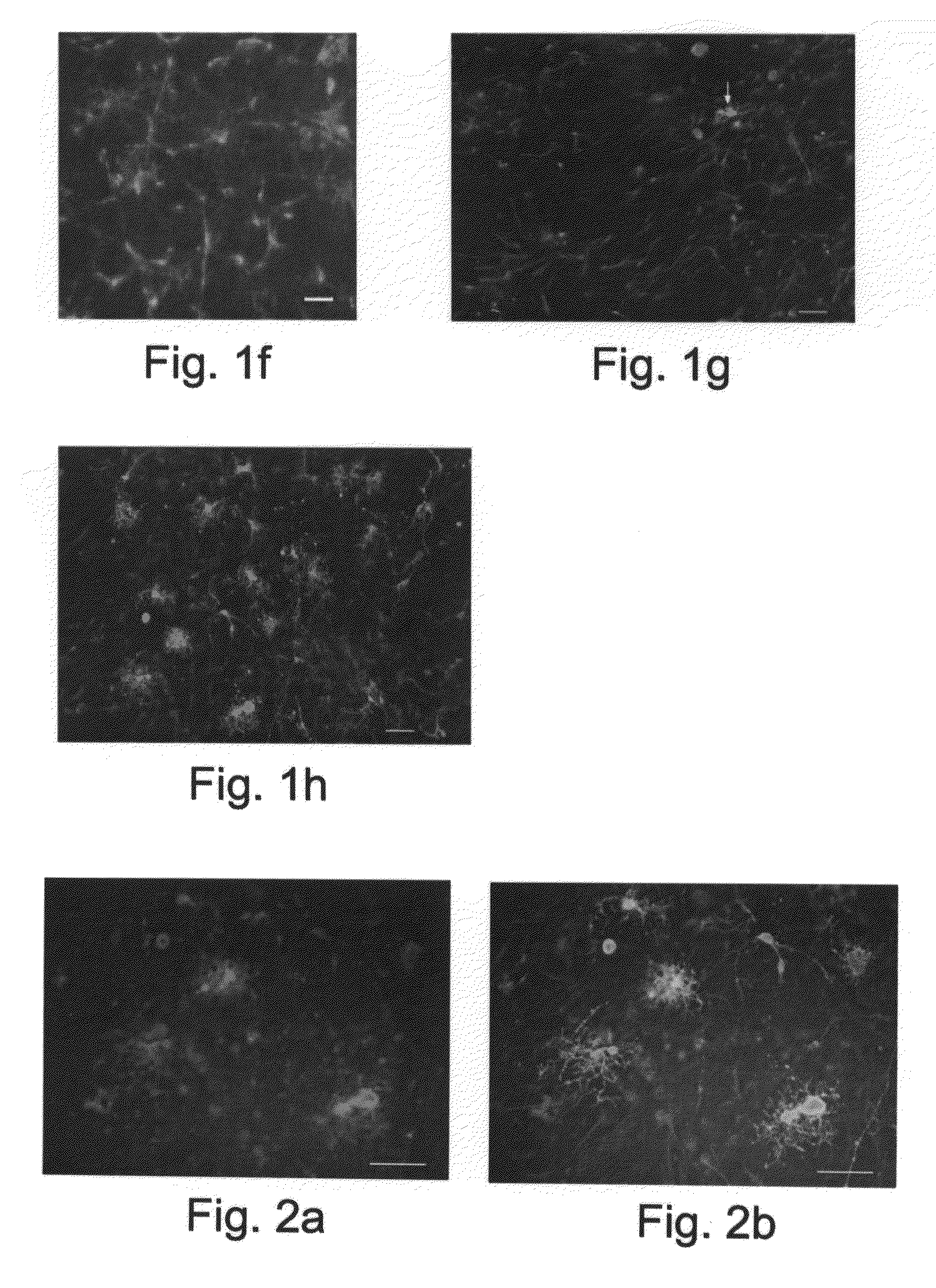Methods of generating glial and neuronal cells and use of same for the treatment of medical conditions of the cns
a technology of neuronal cells and glial cells, which is applied in the field of generating glial and neuronal cells and using them for the treatment of medical conditions of the cns, can solve the problems of many problems in preparing engraftable quantities of human brain cells from fetal or adult human brains, and previous attempts to use human es cell lines for deriving oligodendrocytes have only partial success
- Summary
- Abstract
- Description
- Claims
- Application Information
AI Technical Summary
Benefits of technology
Problems solved by technology
Method used
Image
Examples
example 1
Conversion of Human ES Cells into Cells Expressing Genes Characteristic of the Oligodendrocyte Lineage
[0229]ES cells were cultured with a combination of retinoic acid (RA) treatment followed later by the addition of Noggin addition to produce mature oligodendrocytes, defined by the expression of myelin proteins.
[0230]Materials and Experimental Procedures
[0231]Culturing Media—
[0232]ES1: ESC growth medium—The growth medium (ES1) consisted of DMEM / F12 (Sigma-Aldrich, St. Lewis, Mo.) supplemented with 20% knockout serum replacement (KSR, Gibco BRL / Invitrogen, Gaithersburg, Md.), MEM nonessential amino acids (1 / 100; Gibco BRL / Invitrogen, Gaithersburg, Md.), 100 μM beta-mercaptoethanol (Gibco BRL / Invitrogen, Gaithersburg, Md.), 1 mM Na pyruvate, 2 μg / ml heparin and with 6 to 8 ng / ml human recombinant basic fibroblast growth factor (bFGF, Cytolab, Rehovot, Israel).
[0233]ITTSPP / B27 medium—The medium was composed of 50% (v / v) of DMEM / F12 (Sigma-Aldrich, St. Lewis, Mo.) containing 2% B27 supp...
example 2
Effect of Noggin on the Terminal Differentiation of Human Oligodendrocytes Derived from ES Cells
[0248]Effect of noggin on human oligodendrocyte differentiation was examined by direct visualization and counting of immunostained cells cultured with and without noggin.
[0249]Materials and Experimental Procedures
[0250]Culture and culture conditions—culture conditions were effected as described in Example 1.
[0251]Immunostaining—Cells were fixed in 12 or 24-well tissue culture plastic plates with 4% paraformaldehyde (PFA), washed with PBS, and kept at 4° C. before staining. Non-specific staining was blocked with normal goat serum (5% w / v in PBS) for 30 min at RT. Thereafter primary mouse monoclonal (mMc) antibodies, diluted in 1% goat serum, were administered. Antibodies used were: anti PDGFR (mMc IgG1, Santa Cruz, 1:500), O4 (mMc IgM, R&D Systems, 1:1000), O1 (mMc IgM, received from Dr Sheila Harroch, Pasteur Institute, Paris), anti tubulin-βIII (mMc IgG1, Cowance, 1:1000), and antibody 1...
example 3
Dissociated Neuroglial Sphere Cells (NSc) Differentiating into Mature Oligodendrocytes
[0256]Materials Experimental Procedures
[0257]Culture and culture conditions—culture conditions were effected as described in Example 1.
[0258]Cell expansion—In order to obtain populations of oligodendrocyte precursors that could be passaged and expanded before terminal differentiation, the clusters, aggregates or spheres on matrigel were subjected to one passage by mild trypsinization (as described in Example 1) while still on matrigel (passage 1), and then detached from matrigel and dissociated by trypsin to yield dissociated cells. These human ES cell-derived dissociated neuroglial sphere cells (huEs-NSc), were plated onto cationic substrates for further culture (passage 2), and then terminal differentiation according to the following steps, as outlined in Table 1, conditions 2-4, in Example 1.
[0259]Step D1: Dissociated cells plated on cationic substrates—Tissue culture plates were coated with bov...
PUM
| Property | Measurement | Unit |
|---|---|---|
| concentration | aaaaa | aaaaa |
| concentration | aaaaa | aaaaa |
| Size | aaaaa | aaaaa |
Abstract
Description
Claims
Application Information
 Login to View More
Login to View More - R&D
- Intellectual Property
- Life Sciences
- Materials
- Tech Scout
- Unparalleled Data Quality
- Higher Quality Content
- 60% Fewer Hallucinations
Browse by: Latest US Patents, China's latest patents, Technical Efficacy Thesaurus, Application Domain, Technology Topic, Popular Technical Reports.
© 2025 PatSnap. All rights reserved.Legal|Privacy policy|Modern Slavery Act Transparency Statement|Sitemap|About US| Contact US: help@patsnap.com



